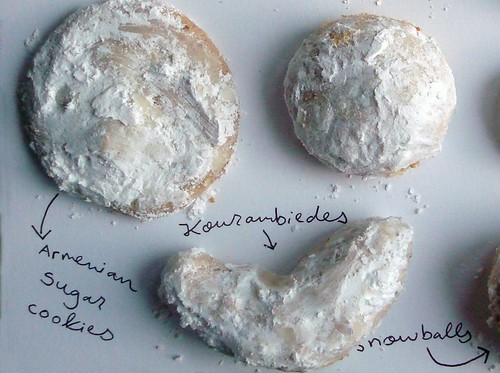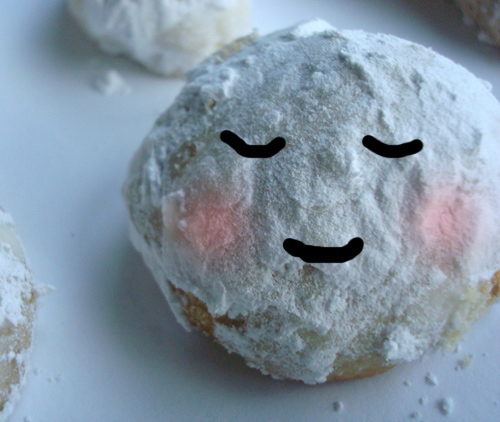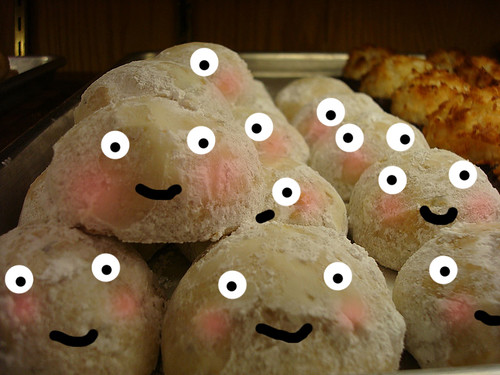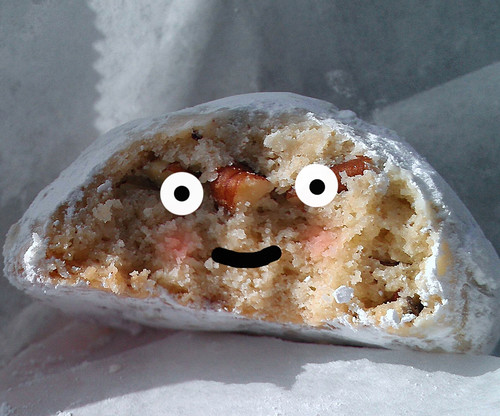Ah, Mexican Wedding Cakes: one of my favorite cakes that is not a cake at all, but a cookie!
And oh, what a cookie. These rich cookies rolled in confectioners' sugar to resemble sweet little snowballs crumble in your mouth in the most delightful way: basically butter and (usually) finely chopped nuts held together by flour and sugar, they begin to shatter and disintegrate the moment they hit your tongue. You may know them as Mexican Wedding Cakes. Or you might know them, with slight variations, under another name: Snowballs, Moldy Mice, Bullets, Russian Teacakes, Melting Moments, Mandulás kifli, Polvorones, Sand Tarts, Sandies, Butterballs, Almond Crescents, Finska kakor, Napoleon Hats (whew!). 
These cookies hail from as many countries as they have names: talk about a universal cookie.
Considering the many variations, is it possible to connect the cookie to a particular place? Well, you might first look back to sugar-rich medieval Arab cuisine. Sweetmeats, candies, and confections containing nuts (usually almonds) and spices were served at special occasions. Next, you spread it to Europe, a sweet tradition quickly adopted by Moors and taken to Spain. From then on it’s like playing Telephone: the concept of the cookie traveled far and wide, with each region taking on their own variations based on ingredients available at the time. This sweet cookie concept was then introduced to the New World by early explorers. Fast forward, and you've got a cookie tradition that has persisted due to the cookie's relative ease in preparation and simple but ultimately satisfying tastiness.
 In the 1950s, they started to appear in American cookbooks as Mexican Wedding Cakes, but it seems that it's really just a new name for an old cookie. They're nearly identical to Russian Teacakes, which were a popular dish at noble Russian tea ceremonies in the 1800s. A popular book in Russia from this era, entitled A Gift to Young Housewives, contains several morsels that are constructed similarly; it’s not hard to see how these treats came to be called Russian teacakes. So what's with the name's cultural makeover? I'm wondering if perhaps the name change was a Freedom Fries-esque name change in the 1950s and 1960s, when the Soviet Union and the United States were at odds with one another? It does seem to have coincided with a period during which TexMex cuisine made its entry into American culture in a big way.
In the 1950s, they started to appear in American cookbooks as Mexican Wedding Cakes, but it seems that it's really just a new name for an old cookie. They're nearly identical to Russian Teacakes, which were a popular dish at noble Russian tea ceremonies in the 1800s. A popular book in Russia from this era, entitled A Gift to Young Housewives, contains several morsels that are constructed similarly; it’s not hard to see how these treats came to be called Russian teacakes. So what's with the name's cultural makeover? I'm wondering if perhaps the name change was a Freedom Fries-esque name change in the 1950s and 1960s, when the Soviet Union and the United States were at odds with one another? It does seem to have coincided with a period during which TexMex cuisine made its entry into American culture in a big way.
But no matter what you'd like to call them, one thing remains true across cultures: these simple cookies are easy to make, and absolutely delightful to eat. 
Mexican Wedding Cakes (Printable version here!)
Makes about 2 dozen 1-inch cookies
- 1/2 cup unsalted butter
- 1/4 cup confectioners' sugar
- 1 cup all-purpose flour, sifted
- 1/2 cup finely chopped walnuts or pecans
- 1 teaspoon vanilla
- Confectioners' sugar, for rolling
Procedure
- Preheat the oven to 325 degrees F. Line two baking sheets with parchment paper.
- In the bowl of an electric mixer, cream the butter and sugar until light and fluffy.
- Add the flour gradually, beating well after each addition; pause to scrape down the sides of the bowl with a rubber spatula.
- Add the nuts and vanilla; beat just until evenly mixed in.
- Shape the dough into balls about 1 inch in diameter and place on the cookie sheets.
- Bake for 15 to 18 minutes, rotating the position of the pans halfway through baking; the cookies are finished when they are lightly browned on the bottom and have a dull finish on top.
- Let the cookies cool on the pan for 5 minutes before transferring to a wire rack. While the cookies are still warm, gently roll them in a bowl of confectioners' sugar. Tap off the excess, and allow them to cool completely. When cool, roll them in the confectioners' sugar a second time before serving; the first coat tends to slightly melt into the cookie, and the second coat will ensure a pretty, snowy appearance.
- Store in a single layer in an airtight container for up to four days.


